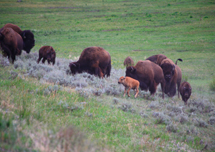| The
American Bison: At Risk of Extinction
The American bison (Bison bison), once roamed North America
30 to 60 million strong (Knapp et al. 1999).
Today, less than 4,700 wild American bison remain in the United
States, mainly within the confines of Yellowstone National
Park (Yellowstone National Park 2007; Gates et al.
2005). The International Union for Conservation of Nature has Red Listed the American bison as threatened with near extinction.
Since the mid-1980’s agents from Montana’s cattle
industry and the federal government have slaughtered over
5,000 wild bison migrating from Yellowstone National Park
(Interagency Bison Management
Plan) putting the survival of the last wild American bison
at risk.
On August 15, 2007 the U.S. Fish & Wildlife Service issued
a finding (PDF,
100kb) in response to a hand-written petition submitted by
a citizen from Minnesota, Mr. James Horsley, (Download Horsley's
Petition) on January 5, 1999, urging the government to
protect the Yellowstone population - the last bison left in
America - under the Endangered Species Act.
The U.S. Fish & Wildlife Service found that the wild population
of American bison currently occupying its native range in
and around Yellowstone National Park is a Distinct
Vertebrate Population Segment. Buffalo Field Campaign
has been circulating a petition
for years to bolster public support for protecting the Yellowstone
population - America's last wild bison - as a Distinct Population
Segment. We encourage you to sign and circulate the petition
and gather support in your local community by collecting signatures
and submitting them to the U.S. Fish & Wildlife Service
(Download BFC’s
petition to protect Yellowstone bison).
Importantly,
the U.S. Fish & Wildlife Service acknowledges that Yellowstone
National Park is the only place in the United States where
wild bison have continuously existed since prehistoric times
(USFWS 2007).
Unfortunately, the U.S. Fish & Wildlife Service fails
to adequately consider wild bison's historic range that spanned
hundreds of millions of acres throughout North America (Hornaday
1889). Under a policy announced in March 2007 (Download
U.S. Department of Interior Office of the Solicitor opinion)
that undermines the intent of Congress, the USFWS redefined
how it determines whether a species is “in danger of
extinction throughout all or a significant portion of its
range.” In it’s finding, the USFWS defined significant
range only where bison currently exist: Yellowstone National
Park and the Gardiner Basin, north of Yellowstone (USFWS
2007). Historic bison range be damned.
We
the people have an opportunity to help the U.S. Fish &
Wildlife Service change their minds and reconsider their decision.
The task before us now is to urge the wildlife agency to thoroughly
review the bison’s historic range, what habitat has
been lost and what must be recovered. We must - and we can
- clearly demonstrate that the Yellowstone bison population
and its historic native range are endangered and warrant Endangered
Species Act protection.
PLEASE
TAKE ACTION TODAY!
|




